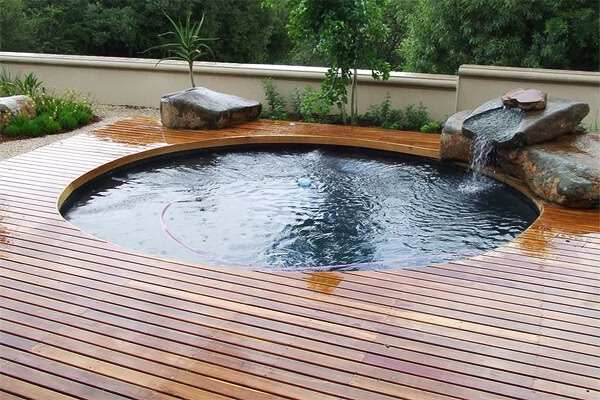Creating a Zen-inspired swim pond is a wonderful way to combine natural beauty with functionality in your outdoor space. This guide will help you design a swim pond that not only offers a refreshing swimming experience but also fosters a peaceful environment aligned with the aesthetics and philosophies of Zen gardens. A swim pond merges the calming aspects of nature with the practicality of a swimming area, making it an ideal retreat for relaxation and mindfulness.
In the following sections, you will learn about the defining features of a Zen swim pond, how to integrate traditional Japanese gardening techniques, the essential materials needed for construction, and maintenance practices to keep the pond serene. You will also discover where to find inspiration for your design. By following these guidelines, you can create a beautiful and harmonious retreat in your own backyard that supports local ecosystems while enhancing your well-being.
Crafting Your Personal Oasis: What is a Zen-Inspired Swim Pond?
A Zen-inspired swim pond is a unique fusion of swimming and nature, intentionally designed to promote tranquility and harmony. Unlike traditional swimming pools that rely on chemical treatments, a Zen swim pond utilizes natural filtration systems to support a diverse ecosystem.
Zen gardens are founded on principles of simplicity, balance, and alignment with nature. In the context of a swim pond, these principles materialize through thoughtful design elements, which include smooth lines, natural materials, and native plants. These factors contribute to a serene swimming experience that connects you with the environment.
A Zen swim pond offers numerous benefits, including its ability to enhance local biodiversity by providing habitats for various species. The natural filtration systems maintain clear, healthy water, which enhances the aesthetic and ecological impact of your outdoor space.
Description: A beautifully designed Zen swim pond, showcasing the perfect balance of water and tranquility in a natural setting. (Source: InTheSwim Blog)
Designing Serenity: Key Features for Your Zen Swim Pond
In designing a Zen swim pond, several key features distinguish it from traditional pools. One significant aspect is the emphasis on natural filtration systems, which use plants and microorganisms to purify water, resulting in an eco-friendly and low-maintenance solution.
Essential aquatic plants, such as Vallisneria americana (tape grass) and Nymphaea odorata (fragrant water lily), play critical roles in maintaining water clarity and providing shade. Including a mix of submerged, floating, and marginal plants fosters a balanced ecosystem while thoughtfully selected materials enhance the beauty of the pond’s edges and surroundings.
You can create serene spaces using natural stones and native plants that thrive in your local climate. This choice not only boosts the pond’s aesthetic value but also supports local wildlife, making your pond an integral part of the ecosystem.
:max_bytes(150000):strip_icc()/is-a-natural-swimming-pool-right-for-you-2737100-final-v6-2c29495607b245a3a79b4a5a9d1e6533.jpg)
Description: An illustration showing the features of a natural swimming pool, including plant life and structural elements that are critical for water quality. (Source: The Spruce)
Embracing Nature: Integrating Japanese Garden Principles
Integrating traditional Japanese garden principles in your swim pond design enhances its beauty and sense of tranquility. Key elements of a Japanese garden include water features, carefully positioned rocks, and selected plants that foster harmony.
To seamlessly blend these aspects with your pond, consider grouping plants based on their specific water and light requirements. Native species, such as Japanese maples and Iris versicolor (blue flag iris), not only enhance visual appeal but also contribute to the ecological balance of your pond.
Creating a layout that allows water to flow naturally, perhaps with small streams or cascades, adds an element of serenity to the space. Thoughtful placement of each element elevates your pond’s overall experience, maintaining a peaceful ambiance.
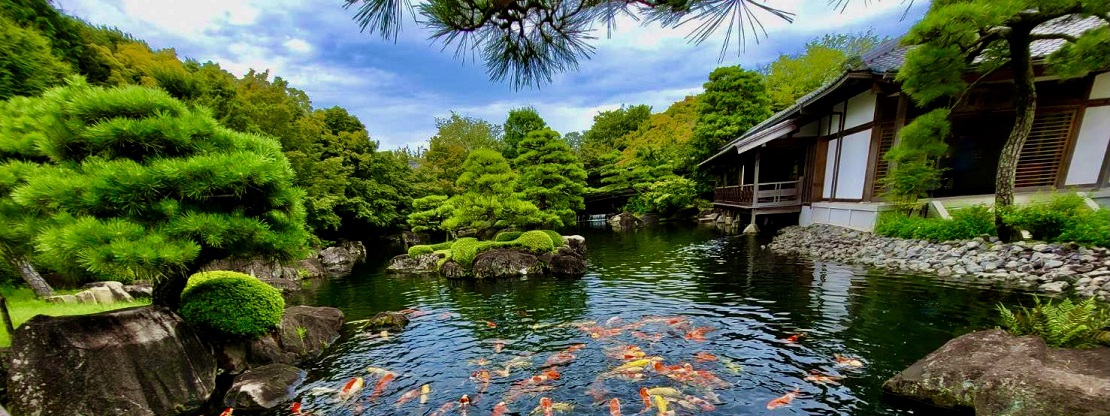
Description: A classic Japanese garden featuring a pond, reflecting the harmonious design and integration of natural elements. (Source: Japan Deluxe Tours)
Building Your Vision: Materials and Construction Tips
Choosing the right materials is crucial for constructing a durable and visually appealing Zen swim pond. Sustainable options, such as natural stone, untreated wood, and native plants, align with the Zen philosophy of living harmoniously with your surroundings.
Start by excavating your chosen site to fit the desired dimensions, commonly around 15×30 feet for medium-sized ponds. Keep depth, shape, and landscaping in mind to create an inviting environment.
Before beginning construction, check local permitting agencies, as regulations regarding residential water features can vary. The installation costs for a Zen swim pond typically range from $65,000 to $250,000, depending on the complexity of your design.
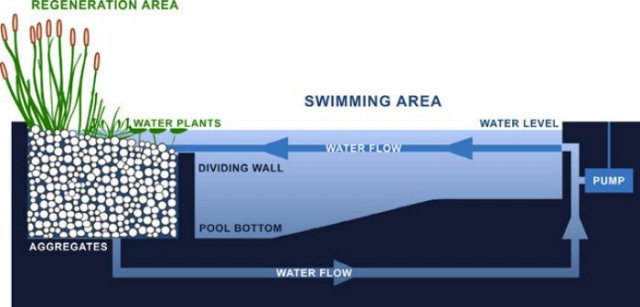
Description: A clear diagram outlining the construction layout and materials used for building a swim pond. (Source: EcoHome)
Balancing Beauty and Function: Maintenance of Your Pond
To keep your Zen swim pond thriving and serene, regular maintenance is essential. Start with routine tasks like removing debris, testing water quality, and caring for aquatic plants.
Natural systems typically require less frequent upkeep compared to traditional pools, but it remains crucial to look for signs of an unbalanced ecosystem. Regularly monitor plant health and water clarity, adjusting your care practices to maintain an inviting swimming area.
Well-maintained ponds not only present a welcoming appearance but also encourage ecological stability. Routinely checking pH levels and ensuring filters operate efficiently keeps the water crystal clear, enhancing your enjoyment of the space.
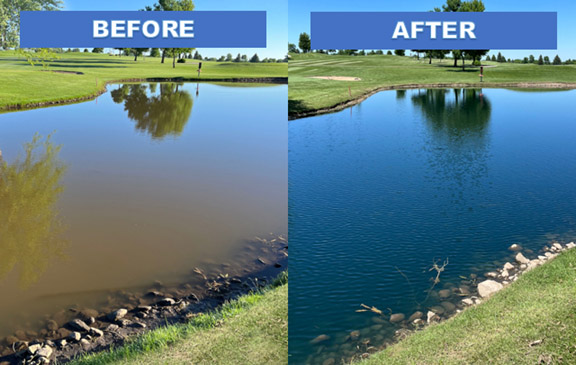
Description: A compelling before-and-after image showcasing the impact of proper pond maintenance on its appearance and health. (Source: Healthy Ponds)
Inspiration Awaits: Finding Layout Ideas and Concepts
As you design your Zen swim pond, seeking the right inspiration can spark creativity. Explore natural landscapes, read books on Zen garden design, and research case studies of successful ponds.
Many online resources display a variety of pond layouts, showcasing how effective designs harmonize both aesthetics and functionality. Learning from these examples can help you craft a pond that meets your specific needs and vision for tranquility.
Consider exploring unique features, such as floating meditation platforms or natural swimming areas, that harmonize with their environments. Reflect on the emotional and sensory experiences you want to elicit from your pond as you gather ideas.
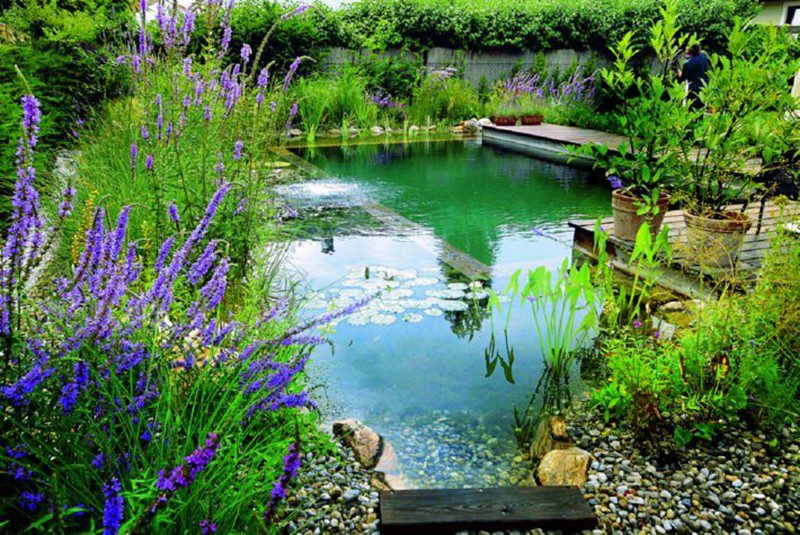
Description: An aesthetically pleasing layout of a natural swimming pond, providing inspiration for readers looking to design their own. (Source: Owner Builder Network)
Creating a Sanctuary: Integrating Meditation Spaces
Incorporating meditation areas into your swim pond design elevates relaxation and mindfulness experiences. You can create these spaces with elevated platforms, floating decks, or sunken seating areas that sit adjacent to the pond.
Opt for natural materials such as stone and bamboo for your meditation area, as these materials integrate beautifully with nature. Adding sound features, like small waterfalls, can enhance the tranquil atmosphere, making your meditation experience even more profound.
By designing areas that encourage quiet reflection next to the water, you expand your pond’s functionality while inviting peace into your routines.

Description: A tranquil meditation space integrated with a pond, exemplifying a serene environment for mindfulness practices. (Source: Meditation Spaces)
Harmonizing with Nature: Environmental and Regulatory Considerations
Before diving into your pond design, it’s essential to understand local regulations regarding water features. Most municipalities require permits for any residential water feature intended for swimming, making it important to consult local governing bodies for compliance.
Additionally, familiarize yourself with health standards that govern water quality and plant usage. By focusing on native plants in your design, you can enhance local biodiversity while maintaining regulatory compliance.
Being mindful of these considerations from the start ensures your investment is protected and promotes sustainability within your pond ecosystem.

Description: An informational graphic illustrating the flow and regulations pertaining to wet retention ponds in urban planning. (Source: Nashville.gov)
Conclusion
Designing a Zen-inspired swim pond beautifully merges art with nature. By understanding the key features, incorporating Japanese gardening principles, selecting appropriate materials, and planning for maintenance, you can create a serene retreat that enhances your outdoor space.
As you embark on this journey, remain aware of local regulations and seek inspiration from existing designs. Your swim pond can become more than just a recreational area; it can develop into a tranquil sanctuary that reflects the beauty of nature—a space that fosters relaxation and mindfulness in your life. Whether you decide to integrate meditation spaces or select native plants, every element will contribute to an oasis of serenity that resonates with peace and harmony.

